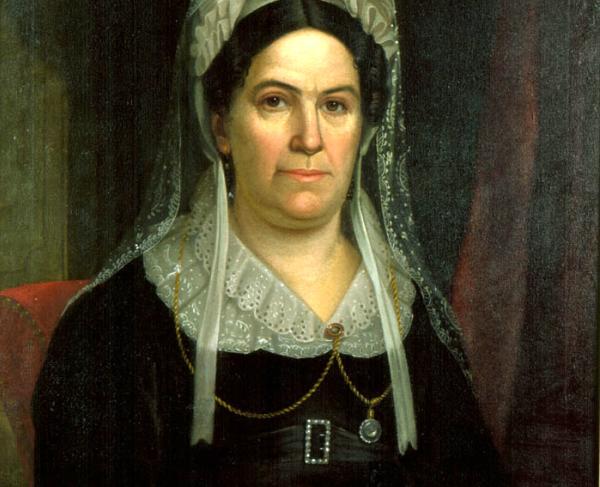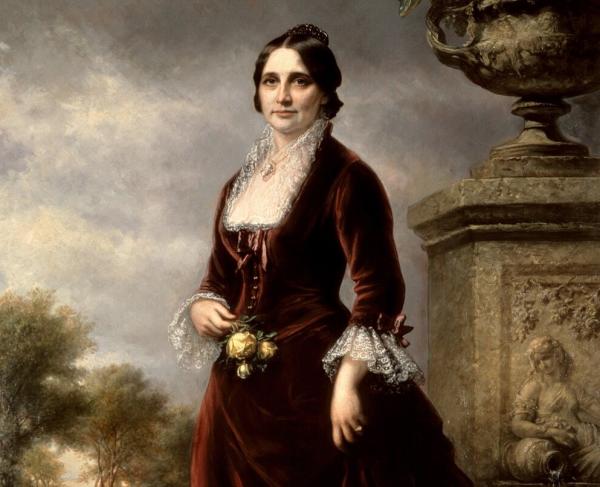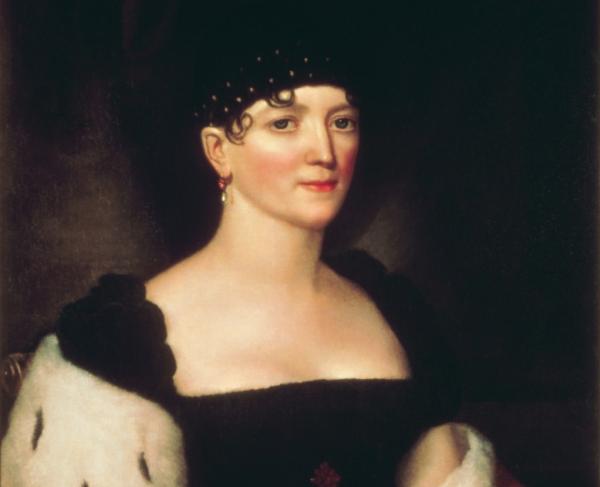Rachel Jackson

Rachel Donelson Jackson’s public life was tragically haunted by rumor and scandal. As the wife of Andrew Jackson, she had been married before, and there was tremendous controversy surrounding her previous divorce. Subjected to an enormous amount of scrutiny as her husband ascended into the national spotlight during his 1828 campaign, she tragically died of a heart attack and never had the chance to prove herself as the First Lady of the United States. She was buried in the dress she had purchased for her husband's upcoming inauguration, and he honored her with the tombstone inscription, "A being so gentle and so virtuous, slander might wound but could not dishonor.”
Rachel was born to Colonel John and Rachel Donelson on June 15, 1767. She was the eighth child in a family of eleven children, and she grew up in the Virginia frontier on a rural plantation in Pittsylvania County. She did not receive a formal education, but she did learn how to read and write. When she was twelve, the Donelson family moved to Tennessee and was one of the founding families of the city of Nashville; a short time later, her family settled in Harrodsburg, Kentucky.
In 1785, Rachel married Lewis Robards, a landowner from a prominent Harrodsburg family. The marriage was not a happy one. He did not trust his wife, and he continually incorrectly accused her of adultery, even when he was committing infidelity himself. The couple temporarily separated in 1788, and after nearly five years of abusive behavior, they permanently cut off their relationship in 1790. Rachel learned that Robards was beginning to file a petition for divorce, which was an uncommon practice for couples in the eighteenth century. During Rachel’s first marriage, her father passed away, and her mother moved back to Nashville. Once her marriage ended, she moved in with her mother in Nashville.
While in Nashville, Rachel met a young lawyer boarding in her mother’s house, Andrew Jackson. By 1791, Rachel and Jackson fell in love and accompanied one another on a trip to visit friends. They married in Natchez, Mississippi, both believing Rachel’s divorce had finalized. The marriage was technically invalid since the divorce between Rachel and her previous husband was not properly processed. Once Lewis Robards learned that Rachel had remarried, he filed a new petition for divorce on the grounds of adultery—which was different from the initial cause for divorce which had been desertion. By 1794, Andrew Jackson and Rachel Robards remarried, and she officially became Rachel Jackson. Because of Rachel’s unusual divorce and complicated marriage to Andrew Jackson, murmurs of adultery and lack of virtue plagued the couple as Jackson became a national hero.
Following her marriage, Rachel took a step back from her social life, and she focused on her family and her commitment to her Presbyterian religion. In 1804, the Jacksons moved to the Hermitage, their plantation near Nashville. They lived there for the remainder of their lifetimes and raised their children. While Rachel did not give birth to her own children, the couple adopted and became legal guardians to several other children. In the early nineteenth century, no legal measures for adoption existed in Tennessee, so it is difficult to find an official record of adoption from this period. However, there were also several children under the legal guardianship of Andrew Jackson in the case that the child’s father died before the child had reached the age of twenty-one. The Jacksons adopted Rachel’s nephew and named him Andrew Jackson Jr. The Jacksons also raised a Native American child, Lyncoya, who had been found on a Creek War battlefield in 1813 near his dead mother.
Andrew Jackson’s popularity soared after the victory at New Orleans in January 1815. By 1824, the war hero launched his bid for the presidency. After losing in an extraordinarily close election, Jackson decided to run for the White House again in a brutal campaign. During the 1828 campaign, Jackson’s political opponents shifted towards ridiculing Rachel, alleging she was an adulteress. Rachel Jackson already had health issues with her heart and lungs, and the stress of the campaign criticism seemed to worsen her current condition. Despite all the odds, Andrew Jackson emerged victorious in the election, but Rachel remembered the horror of the campaign and feared what her life would look like as First Lady of the United States. She even noted that she would “rather be a doorkeeper in the house of God than live in that palace in Washington.”
On December 22, 1828, Rachel died suddenly of a heart attack. Devastated by his wife's death, Andrew Jackson showed disdain for his political enemies; he resented the Whig party for Rachel's death, believing that their constant attacks had impacted her poor health. After Rachel's death, President Jackson’s niece—Emily Donelson—took on the duties of hostess at the White House, and after Emily’s death, Sarah Yorke Jackson assisted in the role.
Rachel Donelson Jackson was the unconventional almost First Lady. She had the strength to leave an abusive marriage and remarry for love—an uncommon choice during this period. Whether the assumptions made about her were true or not, it was the rumor and scandal that impacted Rachel Jackson's life. Her death influenced her husband's presidency and political view.


